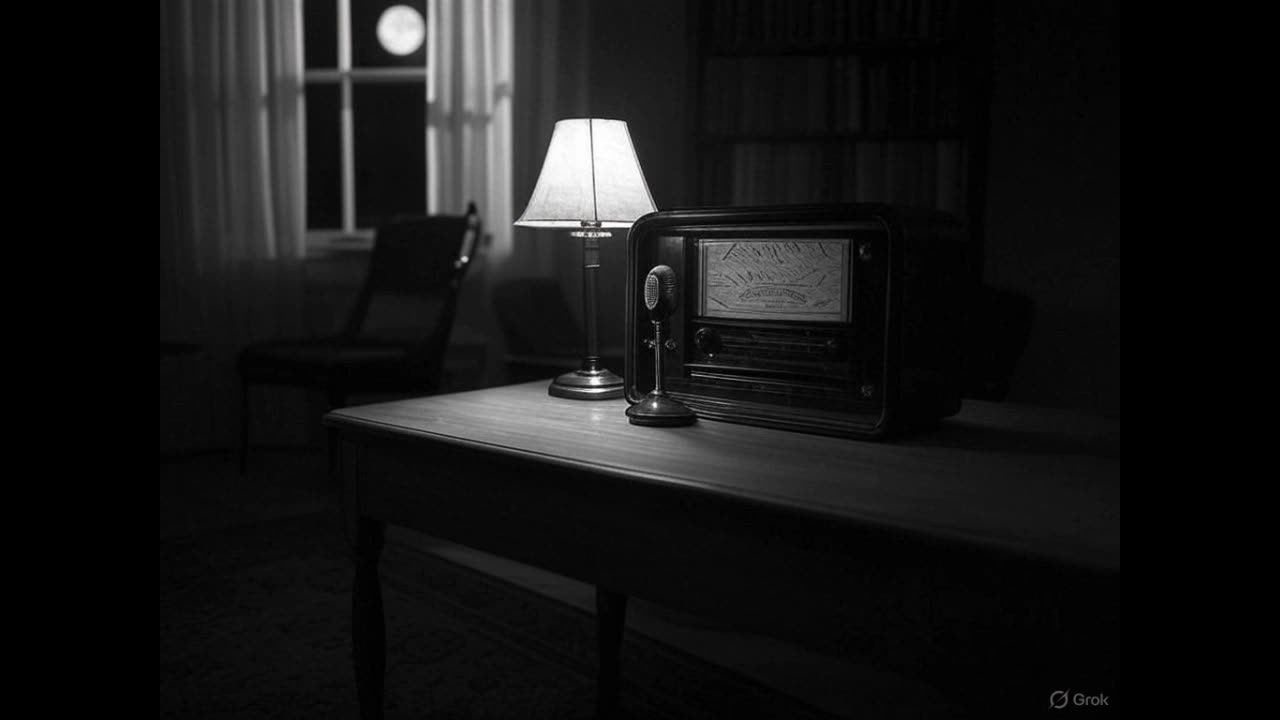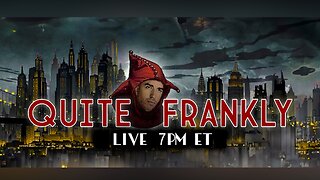Premium Only Content

Lights Out episode titled “Across the Gap” (November 3, 1942)
Episode: “Across the Gap” (November 3, 1942)
Cast and Roles
Arch Oboler as Host/Writer/Director: Oboler introduces the episode with his signature ominous tagline, “It… is… later… than… you… think,” and likely provides narration or minor voice roles, as was his style in the 1942–43 CBS revival.
Lead Actor(s) (Unknown, likely ensemble players): Lights Out casts were typically small, often three actors, using CBS’s skilled performers from New York or Hollywood. The lead is likely a male scientist or explorer encountering the Neanderthal, with a female co-star (possibly a wife or assistant) for dramatic tension. Names like Mercedes McCambridge or Boris Karloff, who appeared in other 1942 episodes, are possible but unconfirmed.
Supporting Actors: Additional voices for the Neanderthal, scientists, or bystanders, likely provided by versatile radio actors doubling roles. The focus was on sound effects and Oboler’s script rather than star power.
CBS Sound Crew: Uncredited but critical, they created atmospheric effects (e.g., cave echoes, grunts, or time-travel sounds) that defined Lights Out’s immersive horror.
Note: Exact cast details are unavailable, as Lights Out rarely credited actors in surviving records, and this episode’s documentation is sparse. The 1942–43 run relied on Oboler’s direction and CBS’s production, emphasizing script and sound over named stars.
Episode Summary
“Across the Gap” (also titled “Neanderthal Man” in some archives) aired on CBS on November 3, 1942, as part of Arch Oboler’s 1942–43 Lights Out revival, sponsored by Ironized Yeast. This 27-minute episode, available for download on the Internet Archive, is a sci-fi/supernatural tale blending horror and speculative themes.
Opening: Oboler sets the mood with a tolling bell and his chilling warning, urging listeners with weak constitutions to turn off their radios. He introduces the story as a fantastical journey into the past.
Plot: The story likely centers on a scientist or adventurer who, through experimental technology or supernatural means, travels back in time to encounter a Neanderthal. The title “Across the Gap” suggests a leap across evolutionary or temporal divides. The Neanderthal, portrayed as a primal, menacing figure, may threaten the protagonist, creating tension through its brute strength or alien nature. Oboler’s script probably uses vivid sound effects—grunts, footsteps in a cave, or the hum of a time device—to heighten the horror. A female character (e.g., a wife or colleague) may be involved, adding emotional stakes as the protagonist faces the primal past.
Climax and Twist: Oboler’s stories often feature a shocking twist or moral. The protagonist might struggle to return to the present, or the Neanderthal could reveal a surprising human trait, forcing reflection on humanity’s origins. Alternatively, the encounter might end in tragedy, with the time traveler trapped or destroyed, a common Lights Out trope.
Resolution: The episode likely concludes with Oboler’s narration, tying the story to a broader warning about science, hubris, or human nature, followed by a lighthearted Ironized Yeast plug to ease the tension.
Tone and Style: The episode balances sci-fi adventure with horror, using Oboler’s signature stream-of-consciousness narration and sound-driven storytelling. It’s less gory than earlier Lights Out episodes, reflecting the 1942 prime-time slot (8:00 p.m. ET), but still eerie for family audiences.
Note: The episode’s exact plot is not fully detailed in surviving summaries, and no transcript is widely available. The “Neanderthal Man” title suggests a focus on prehistoric themes, possibly inspired by early 20th-century fascination with human evolution. If you’d like me to search for audio or fan discussions on X for more specifics, let me know
U.S. News on November 3, 1942
Based on historical records and news archives for November 3, 1942:
Midterm Elections: The U.S. held midterm elections on November 3, with Republicans gaining seats in Congress, reflecting public frustration with wartime economic controls and President Franklin D. Roosevelt’s policies. Newspapers like The New York Times reported a shift toward conservative sentiment, though Democrats retained control.
World War II Home Front: The war dominated headlines, with rationing of gas, sugar, and coffee tightening. On November 3, reports highlighted the Office of Price Administration’s efforts to stabilize prices, as inflation strained families. War bond drives were also prominent, urging citizens to support troops.
Battle of Guadalcanal: U.S. Marines were engaged in fierce fighting in the Solomon Islands, with November 3 updates noting naval reinforcements arriving to counter Japanese forces. The campaign, a turning point in the Pacific, gripped public attention.
Entertainment News: Hollywood and radio were wartime morale boosters. On November 3, Variety reported on radio’s role in supporting the war effort, with shows like Lights Out airing alongside patriotic programs.
These events underscored a nation mobilized for war, with radio providing both news and escapism for anxious families.
International News on November 3, 1942
Battle of El Alamein: In North Africa, the Second Battle of El Alamein (October 23–November 11) was underway, with Allied forces under General Bernard Montgomery gaining ground against German Field Marshal Erwin Rommel’s Afrika Korps. On November 3, global news reported Allied breakthroughs, a critical step toward victory in the desert campaign.
Eastern Front: The Battle of Stalingrad raged, with Soviet forces resisting German advances. On November 3, international dispatches noted heavy casualties and the city’s dire conditions, marking a pivotal moment in World War II.
Japanese Expansion: In the Pacific, Japan reinforced positions in New Guinea and the Solomon Islands. November 3 reports highlighted Allied efforts to disrupt Japanese supply lines, tied to the Guadalcanal campaign.
Holocaust Developments: Though not widely reported at the time, November 1942 saw increased Allied awareness of Nazi atrocities. Diplomatic channels discussed Jewish deportations, though public knowledge remained limited.
These global stories reflected a world consumed by war, with Lights Out offering a fantastical escape from grim realities.
Cultural Impact, If Any
The episode “Across the Gap” had modest direct cultural impact as a single broadcast in the 1942–43 Lights Out revival, but its context and themes contributed to broader trends:
Sci-Fi and Horror Boom: The episode’s sci-fi premise, blending time travel and prehistoric encounters, tapped into 1940s fascination with human evolution and scientific progress, spurred by discoveries like Neanderthal fossils. The 1942–43 Lights Out revival, including this episode, fueled radio’s growing horror genre, paving the way for shows like Suspense and Inner Sanctum. Its prime-time slot broadened its audience, including families, unlike the late-night original run.
Oboler’s Influence: Arch Oboler’s focus on psychological and speculative horror, evident in “Across the Gap,” distinguished Lights Out from gore-heavy predecessors. His use of sound effects and narration influenced radio drama techniques, inspiring later audio storytelling, including modern podcasts.
Wartime Escapism: Airing during World War II, the episode offered a thrilling distraction from rationing and war news. Its fantastical premise allowed listeners to explore existential questions about humanity’s past amid uncertainty about the future, resonating with a war-weary audience.
Limited Legacy: As one of many Lights Out episodes, “Across the Gap” lacks standout fame like “Chicken Heart.” Its survival in archives ensures niche appeal among old-time radio fans, but it didn’t spawn specific cultural references or adaptations. Its significance lies in reinforcing Lights Out’s reputation for innovative horror.
-
 LIVE
LIVE
Nikko Ortiz
2 hours agoBetter Than Escape From Tarkov? - Rumble LIVE
122 watching -
 31:50
31:50
MattMorseTV
1 hour ago🔴Trump prepares for WAR with RUSSIA.🔴
1.27K10 -
 1:03:58
1:03:58
TheCrucible
3 hours agoThe Extravaganza! EP: 43 (9/25/25)
104K10 -
 1:14:53
1:14:53
Kim Iversen
4 hours agoHegseth Summons Top Brass — Is War With Russia Incoming?
33.6K119 -
 LIVE
LIVE
StoneMountain64
5 hours agoBattlefield 6 News and Extraction Gaming
121 watching -
 9:21
9:21
Tundra Tactical
2 hours ago $0.31 earnedThe Dumbest Gun Questions Of All Time Answered! Part 2
4.55K1 -
 LIVE
LIVE
LumpyPotatoX2
1 hour agoWorld of Tanks 2.0 | Public Service Announcement - #RumbleGaming
43 watching -
 LIVE
LIVE
GritsGG
4 hours agoQuad Win Streaks w/ Bobby Poff!🫡 Most Wins in WORLD! 3600+
37 watching -
 LIVE
LIVE
Badlands Media
11 hours agoQuite Frankly Ep. 23
466 watching -
 1:31:41
1:31:41
Redacted News
4 hours agoNew Charlie Kirk Video Evidence Could Change EVERYTHING | Redacted w Natali & Clayton Morris
182K209